Cyclades
(Photos WS)
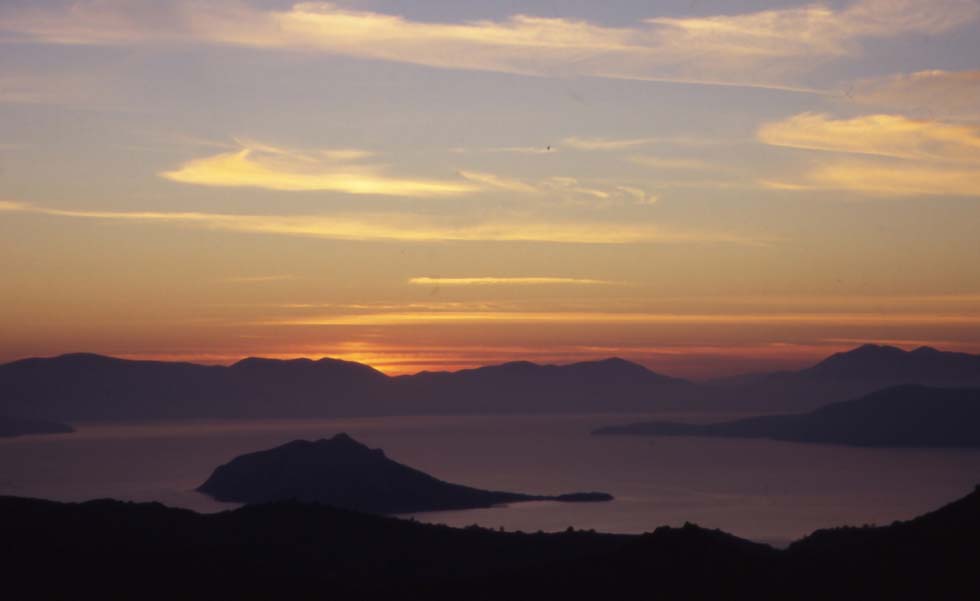
Argosaronic Gulf
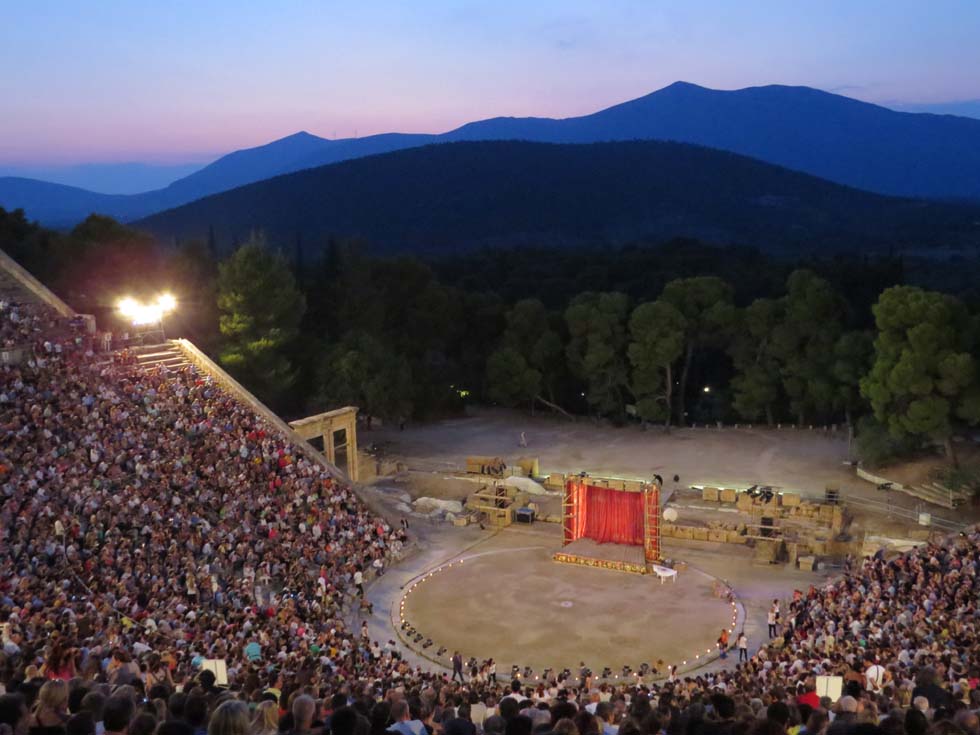
Epidavros (photo JamesBondTwo)
One of the most fascinating tours to be undertaken in the Aegean takes the visitor to Epidaurus. At sunset, after departure from the isle of Aegina, passing along Agistri and some smaller islets, the tourist boat enters the Bay of Epidaurus, surrounded by the towering Peloponnese mountains. The small city of Palea Epidavros receives the visitor with the humid climate typical for that region, characterized by its orange plantations. A Pullman bus takes the passengers to the archeological site of the world-famous amphitheatre of the antique Epidaurus, accompanied by thousands of motor-cars. Climbing up to the upper ranks of the theatre, the sight compensates for the pains. The evening glow over the mountains in the west, the pine-tree forests surrounding that more than two thousand years old monument of culture, and the ten thousand people sitting below. And when the antique tragedy of Sophocles or Euripides culminates into killing mother or brother, the sight of the lights from villages miles away remind us that we’re living in an age of our own. The return journey on the boat past the islands towards the glittering lights of Aegina at three o’clock in the morning provides the finishing highlight of that unforgettable night.
You may approach Aegina also from the south, after a visit to Hydra, the island which consists entirely of rocky mountains overtopping a tiny old town. A flag is flying on a rock, deep below are the small stone houses and the narrow roads, consisting of stairs, where donkeys are the means of transport. And donkeys are waiting on the quay, where yachts and hi-speeds, the “Flying Dolphins” are mooring. During that summer in the late 90s a car-ferry of Hellenic Seaways, arriving from Piraeus or, on the return trip, from lovely Spetse Island, enters the narrow harbour basin of Hydra, though no motorcars are unloaded. They have no access to Hydra, neither to Spetse Island, and then this ferry route disappeared.
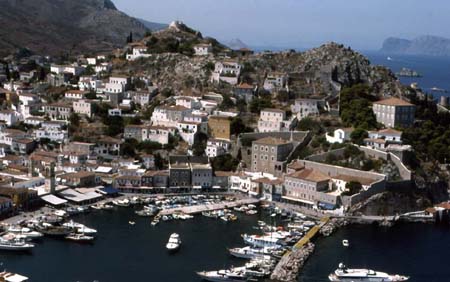
Hydra
|
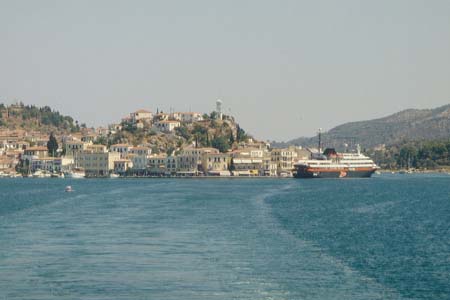
“easyCruise One” at Poros, 2007
|
On that day it’s the “Poseidon Hellas”, which manoeuvres to the quay of Hydra. After departure, other islands off the coast of the Peloponnese are coming into view, arid and stony. Passing terrifying reefs, the ship enters a strait not wider than a river, sliding along taverns and shops of a little town, overtopped by a bell-tower. It’s Poros. Decades ago the armoured cruiser “Averof”, a relic of 1910, was lying at anchor in the nearby bay. In summer 2007 the little cruise vessel “easy Cruise One” was a regular visitor, but cruise ships of usual size cannot call here.
Passing coastal hills covered with forests and rocks, the ferry approaches Methana, a health resort for pensioners, the sanatoriums surrounded with palm trees, and after a short stop it crosses the Argosaronic Gulf on the way to Aegina. At starboard, the Mount Oros, though only 500 metres high, is preventing the view of the St. Nektarios Monastery, the much-beloved place of pilgrimage. Also the Temple of the goddess Aphaia cannot be seen from the ship. Like the Parthenon and the Theseion of Athens, it is a miracle of the classic Hellenic architecture. The British historian Gerald Ephraim Nektarios Thompson, living in Aegina, described the legend: “Aphaia had escaped from the unwanted intentions of King Minos of Crete by flinging herself into the net of a fishing boat. The amorous advances of one of the crew were likewise avoided by leaping into the sea off Aegina, and then hiding in the dense forest, protected by her friend, the huntress goddess Artemis.”
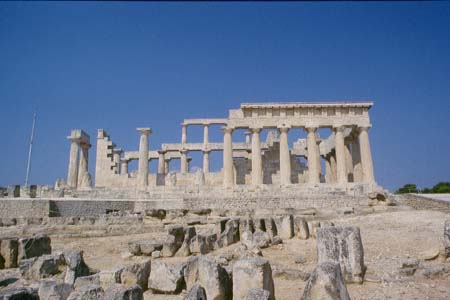
Aphaia temple
|
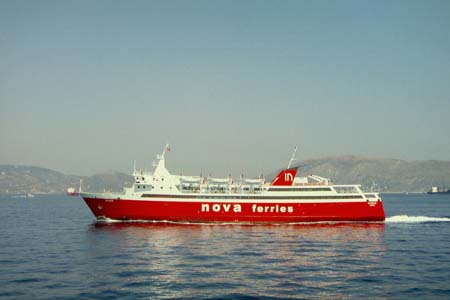
“Phivos” (ex “Punta Europa” of ISNACA of Spain), Piraeus – Aegina 2005
|
There are modern legends, too. Sitting once in a tavern in Aegina, Christophoros, a retired Captain (and poet), told us amazing stories, the most bizarre one of a cargo transport to communist North Vietnam during the years of war. The ship transported some goods, covered however with scrap, officially bound for Port Sudan. There they tore the falsified papers, took the new documents and went to Haiphong…
Under Kapodistrias, the first President of modern Greece, Aegina had been the capital of the liberated country. Now, motorcars and a few trucks and tourist buses embark here on the ferry. The travel continues past the single remaining column of the Apollo Temple, along the green coast of Aegina and then, crossing the Gulf past a dozen freighters and tankers lying in the roads, along Salamis Island. Hidden behind a hill is the bay where, decades ago, the last former ocean liners have been laid up, in the neighbourhood of shipyards, oldtimer ferries, scrap heaps and, on the opposite shore, the Perama suburbs, its roads hemmed by workshops and filled with black or Asian dealers, the nearby container terminal during these months desolated by strike – another world.
Almost 2,500 years ago, the fleet of the Persian invader Xerxes had been defeated in the bay by a much smaller Greek naval force. Themistocles, who saved world’s first democracy by that victory, had fortified Athens together with its port Piraeus. Then Pericles could build up Athens as Europe’s first center of culture, with the Parthenon as the monument of classic architecture. The Athens of our days, with all its suburbs counting more than five million inhabitants, stretches over hills and along bays, its accumulation of houses glimmering under heat and haze.
The white funnel of Royal Caribbean’s “Splendour of the Seas”, high like a skyscraper, marks the entrance to the port at Cruise Terminal B on that day. A striking red catamaran of Hellenic Seaways passes by. In the dock at Cruise Terminal A, a Celebrity megaship is berthing, its blue funnel sporting the label “X” of famous Greek shipping pioneer Chandris. The former ocean liner terminal however is dilapidated since decades. Innumerable ferries are moored on the piers and the “Speedrunner I”, a wavepiercer catamaran, once as “Hoverspeed Great Britain” the sensation on the Dover – Calais run, is almost hidden away. After disembarkation, the horror of the Piraeus road traffic is capturing the traveler.
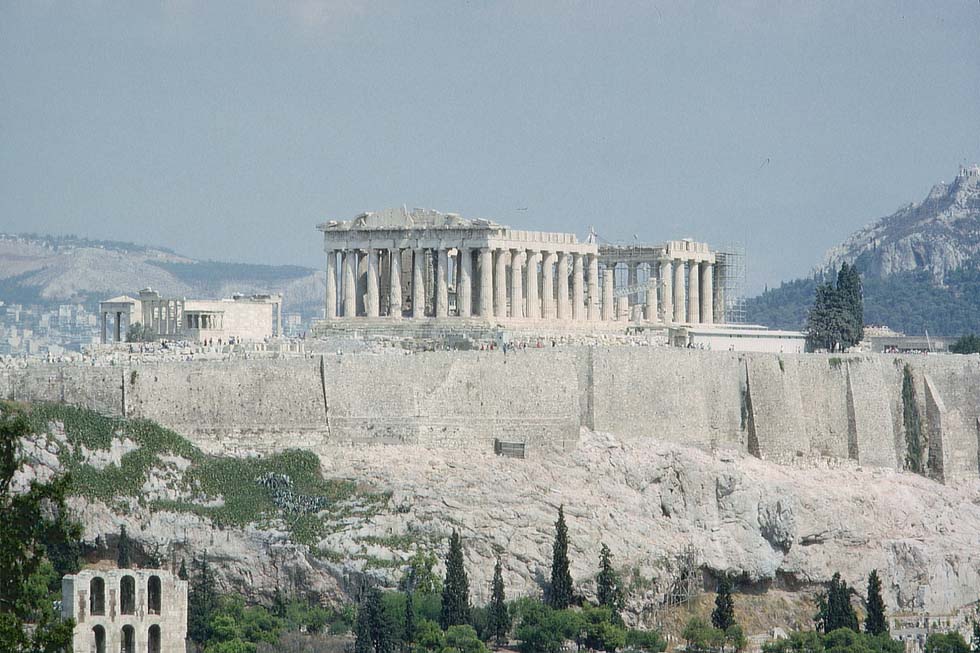
Parthenon
Not Piraeus, but the Cyclades island of Syros has been the prominent Greek harbour at the beginning of the steam age. Greece had successfully fought for independence, supported by England, France and Russia – and the growing city of Syros, baptized Hermoupolis, with its catholic episcopacy protected by France, was almost chosen as the capital of Greece, but the French did not accept any other King on the island. At least, Syros became in 1837 the Greek port-of-call of the first French and Austrian steamship lines to Constantinople. And passengers for Egypt had to change steamer in Syros, not Piraeus.
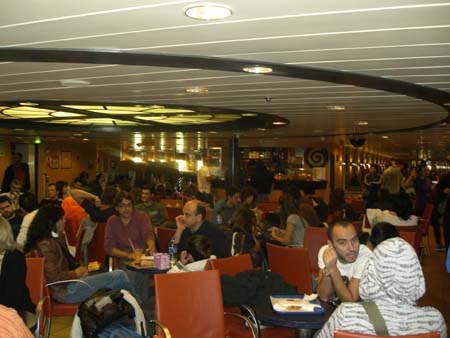
“Ithaki” Mykonos – Piraeus 2008
|

Piraeus, the last old harbour inn
|
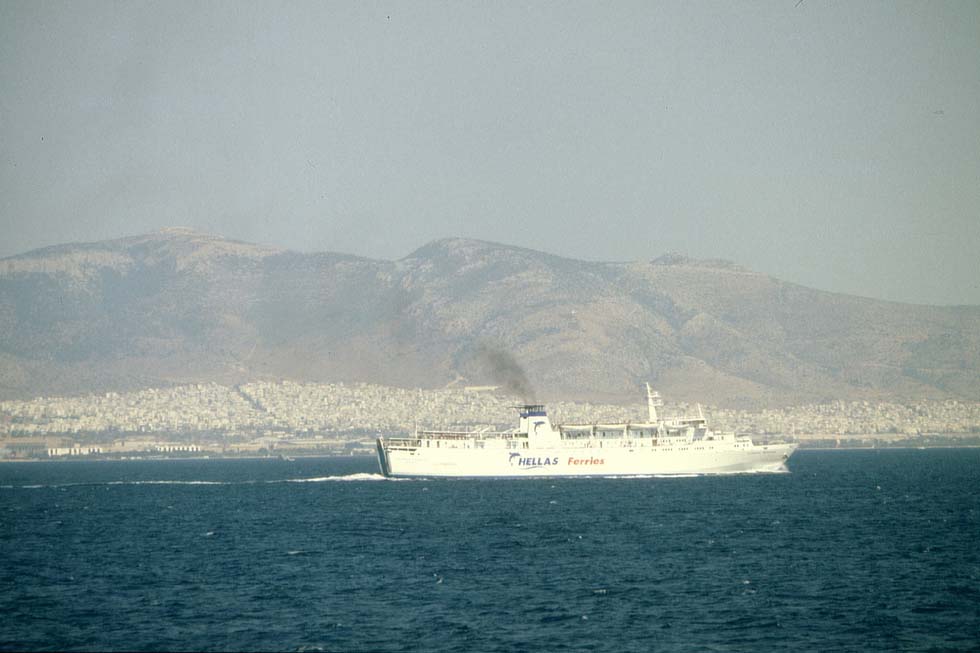
Hellas Ferries after departure from Piraeus, 2003
We have been full of curiosity about a trip to Syros island. The ticket office recommended to take Blue Star Ferries, departing either in the evening or early in the morning, but did not mention a Hellenic Seaways departure at high noon. And so, toward the end of October 2008, we start early before daybreak, still at darkness, for the port of Piraeus. The ships of Blue Star, docking on the quay, are still under the full glamour of their lights. Cars and trucks are loaded through the stern gate, while passengers take the escalator to get to their Pullman chairs or their seats in the economy saloons. The ship, the “Blue Star Ithaki” of 10,000 tons, was put in service in 2000 as the first vessel of the young company. It is interesting to watch the hustle and bustle on the quay from the open deck, surrounded with truck-drivers and other professionals, who have their breakfast with coffee and are smoking like chimneys. The neighbouring “Blue Star Paros” departs first, followed by our “Ithaki”. Passing by the ANEK ferries, the red “Highspeeds” of HSW, the monohull “Speedrunner II” and the old GA ferries, we enter the open sea.
The sun rises behind one of the “Celebrity” giants, its silhouette contrasting sharply against the bright horizon. Outside the harbour, the colourful cruise ship “Ocean Village” is making clear to arrive. Our course leads first in approximately southern direction, while several ships are approaching from the east with Piraeus as destination. After a change of course toward southeast, hills can be seen encircling Cape Sounion, the utmost tip of the mainland, crowned with the pale columns of the Temple of Poseidon. One should have binoculars at hand… With the naked eye a small unprepossessing island can be distinguished in front of the mainland. It is Makronissos, where the Greek military junta of 1967 had kept imprisoned their opponents for fear of a civil war.
Bald, barren and rocky appears the next island on port: Tzia (officially named Kea), of the same scanty nature as other islands of the Cyclades. On starboard it is Kithnos and on port, quite tiny, Giaros. And steadily blows the Meltemi north-wind, creating foam-crowns on the waves with little rainbows in the sunlight. The weather report has predicted 7 Beaufort, corresponding to a moderate gale.
Another island comes closer on starboard, brown, mountainous, barren, too. It is Syros, as a traveler companion affirms. At short distance its northern cape is surrounded, white surf breaks against rocks. Now, going on southern course and passing the eastern shore, houses have come into sight. We are turning into the harbour bay, which is overtopped by two pyramid-shaped steep hills, densely developed, the houses stringed closely one to the other in streets and lanes, leading steeply uphill to a church on each top. The one to the left is the Catholic, the other to the right the Orthodox. A native woman knows to tell that the different religions live here in harmony and the priests perform the wedding ceremony of mixed couples in common.
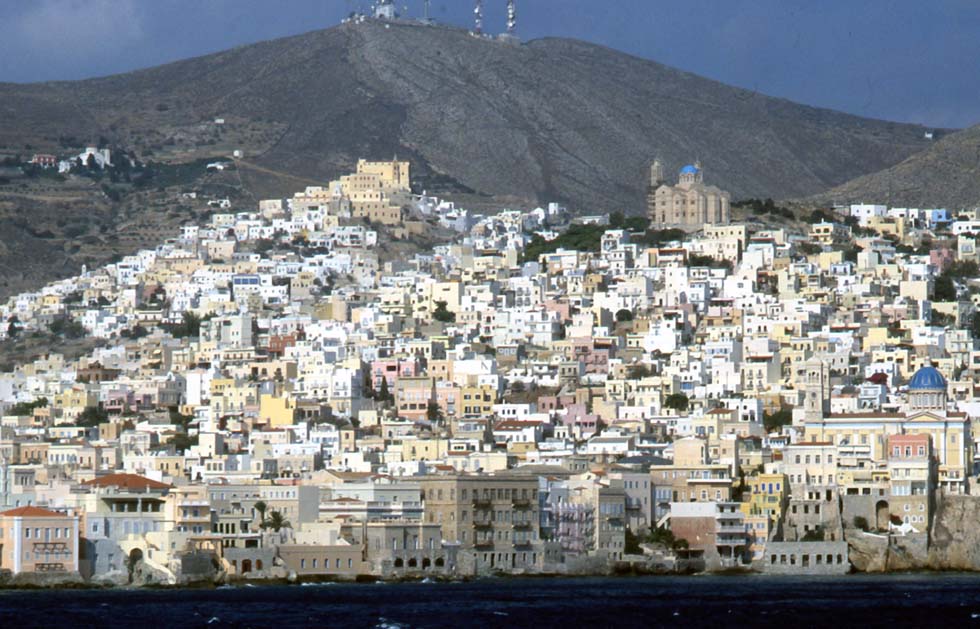
Syros
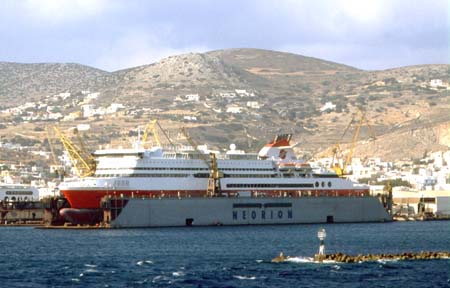
“Superfast XII”, Neorion shipyard, Syros 2008
|
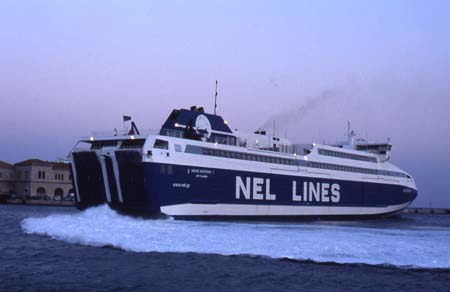
“Aeolos Kenteris I” Andros – Lavrion, Syros 2008
|
Performing a skilful manoeuvre, the ship docks with the stern on the quay, ready for the unloading and loading business (bow thrusters have made the proceedings much easier, while earlier the anchor had to be used). The red “Superfast XII” is lying in the dry-dock of the one-and-a-half century old Neorion Yard in the harbour basin (years ago, the Greek say, even Soviet warships had been repaired here). In the narrow streets, passing by the palatial town hall, built under the reign of King Otto by his Bavarian architect Ziller, the visitor gets to the numerous churches and chapels. In one of them he can admire an early painting of El Greco, missed for centuries and just recently identified. Before he may climb up the steps to the Metropolitan Church, he should pay a visit to the theatre, not really an imitation of the Scala of Milan, as it is exaggeratedly said, but nevertheless astonishing for this remote place. And who then even discovers the sign of the Austrian consulate, may feel to have stepped back into the age of the Habsburg dynasty, when the steamers of the Austrian Lloyd had called at Syros.
In the evening another ship approaches, certainly more striking, the “Aelos Kenteris I” of NEL, a blue/white monohull-highspeed, sporting an extremely pointed stem. It performs a breathtaking manoeuvre against the blowing north-wind, leaving a white-foaming trace in its wake like an ornament on the nightly sea. According to the timetable she has come from the Cyclades island of Milos, with stops at Kimolos and Sifnos, and is bound for Tinos and Andros. But she is empty (why a gas-guzzler like that could be employed on those branch lines may be kept as a mystery of Greek shipping policy).
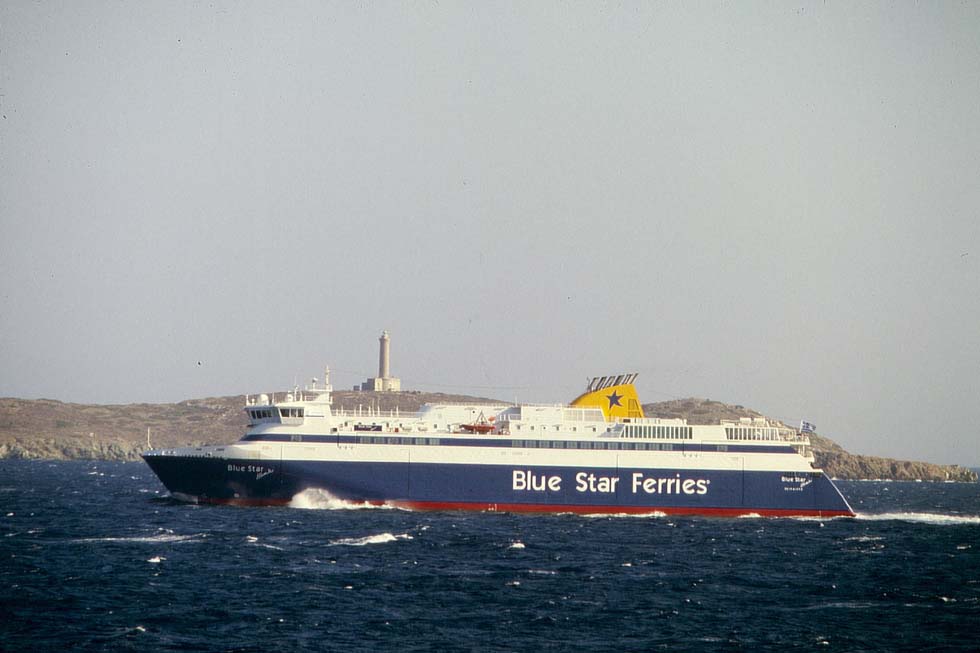
“Blue Star Ithaki” Piraeus – Mykonos, Syros 2008
Next day we are boarding the “Blue Star Ithaki” from Piraeus, heading for the next island, which stretches in the northeast on the horizon. It is Tinos, like its neighbouring island of Andros barren and mountainous, topped with a rocky pyramid under the gloomy sky. Docking is accomplished in a tiny port basin, the famous pilgrimage church in the background.
Hilly, but of lesser height appears another island in the northeast, bald and barren, too, but a midsize white cruise ship is lying there, the “Nautica” (ex “R Five”). An announcement informs of our running into the old port of Mykonos. An aged ship stays waiting, the “Penelope A”, one of the ferries built for Sealink UK in the 1970s, almost historic yet. A stroll leads through the shore lane, flocks of tourists streaming there. Mykonos has become a famous resort after Jacqueline Kennedy had spent her holidays here. In spite of all the bustle, the small white houses, chapels and the well-known windmills are spreading still nowadays the charm of an ancient fishermen’s village.
It’s time for departure on the “Blue Star Ithaki” back for Piraeus. In the new port of Mykonos just has entered the “Costa Fortuna”, a giant of 103,000 tons, coming from Venice. Despite the storm she can be moored on the quay. Another cruise ship, the “Grand Mistral” of Ibero Cruzeros, turns northward, seemingly not being able to do the same at this time. Well after six hours, at 8 o’clock in the evening, the “Ithaki” passes the harbour entrance of Piraeus, this time towered by the imposing, glamorously lit 137,000-ton “Navigator of the Seas”.
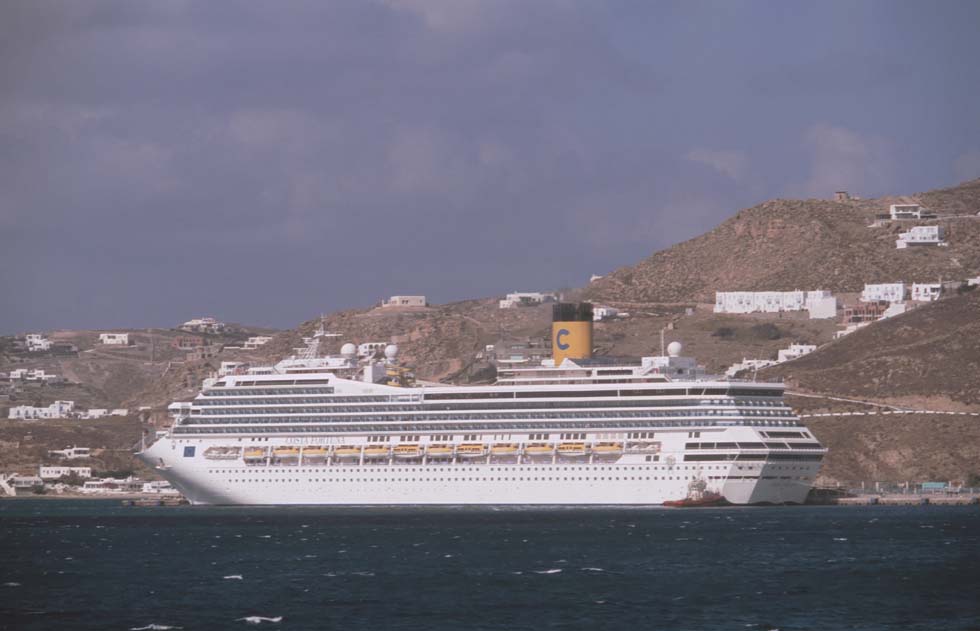
“Costa Fortuna”, Mykonos 2008
To make a trip on board one of the breathtaking high-speed catamarans, which are moored at Piraeus for crossing the Aegean Sea, was always a dream. On a day in early autumn it had become true: We are boarding the “Highspeed 5” of Hellenic Seaways, a catamaran built by Austal for a speed up to 40 knots. The upper deck, situated above the car deck, is equipped with aircraft-like economy and business class seats. Stairs are leading to the bridge deck with a comfortable VIP class saloon, empty for the present. Fortunately enough there is also a small open deck above the stern and from this wonderful place the ships in the harbour of Piraeus can be looked at, the multitude of ferries and on that day the “Ocean Village” and the “Oceanic II” with a Scholar Ship label, identified as the ex-“Mona Lisa”, ex-“Kungsholm” of 1966.
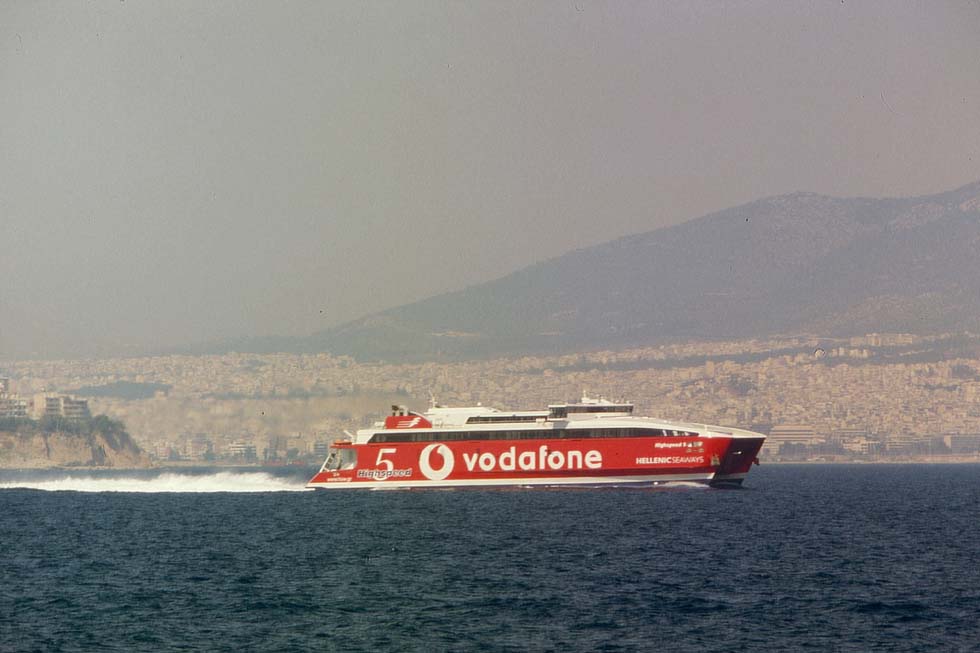
“Highspeed 5” departing from Piraeus, 2011
After passing the lighthouse, the catamaran is speeding up, the splashing of the sea gets fiercer and a stiff wind blows over the open deck. The noise is so loud that it’s impossible to understand one’s own words. The Prophet Elias Hill of Piraeus, the Bay of Faliron (where the “Averof” is preserved as a museum ship) and the marinas of Glyfada are quickly left behind.
The course is towards the Cyclades. After another hour the first island comes into view on port side in the distance, then a second and a third one, mountainous and arid. Somewhere white houses are scattered. Maybe it’s Serifos (decades ago we enjoyed our honeymoon there, and King Constantine arrived aboard a destroyer, by chance of course). After a traveling time of three hours, the sun dips in the horizon. A mountain on an island in the west rises its top like a pyramid, while in the east other remote islands are passing by. Who may know all their names? It’s getting dark.
A black mountain ridge stands out against the dusk. Lights of a village are glowing. Other mountains are rising in the darkness. The “Highspeed 5” reduces speed. The catamaran doubles a rocky cape and approaches slowly a tiny harbour, its illuminated little houses towered by a threatening rock face. A shuttle bus climbs up a daredevil road…
It’s Santorini, an island of volcanic origin, where the “Highspeed 5” has arrived in some 150 miles distance from Piraeus, covered within 4 hours. The other day, a bright sunny morning, small lanes lead the visitor’s way past taverns and jewelry shops to the breathtaking edge of the little town Thira – high above white old houses and blue-painted cupolas of small chapels, perched on the rocky slope, with the glittering sea more than hundred metres below. What a sight!
On the opposite shore of the bay is situated a little island and some miles away another one, both consisting of black volcanic rocks, hemming in the strait which has to be passed by the incoming and outgoing ships. Deep below in the bay, appearing like toys, two big cruise ships are anchored, the “Zenith” of Pullmantur and the “Royal Princess” of Princess Cruises. They cannot be moored on the tiny quay named “Skala”, what means “stairs”. In the past, all boat-passengers had to climb up to the town over stony stairs or better they took a donkey. Now the ferries are calling at a new port, but the donkeys still are waiting at the Skala, where the cruise passengers arrive on a tender. Most of them prefer to use the new cableway on their sightseeing-tour to the old town. A museum, carved into the volcanic rocks, preserves treasures of Santorini’s Minoan-style culture, which was destroyed abruptly around 1600 B.C., when a volcanic eruption did crush the island.
Next day the 90,000-ton “Brilliance of the Seas” has dropped anchor in the bay. When the day gives way to night, her lights and neon-blue Royal Caribbean funnel-markings are reflected on the calm sea. While sitting on a terrace high above the bay, we get joined by an old man. As he obviously is a local, we ask him in his language about the disaster of the “Sea Diamond”, which had capsized some months ago after having hit a reef not recorded by the nautical charts. He shows us the place in sight of the town where she must lie at the bottom of the sea and then he is telling fanciful stories, surely local rumours, but anyhow fascinating and mysterious, reminding of tales and tragedies from Greek mythology of the past.
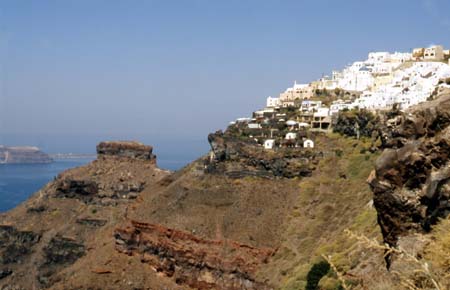 Thira, Santorini
Thira, Santorini
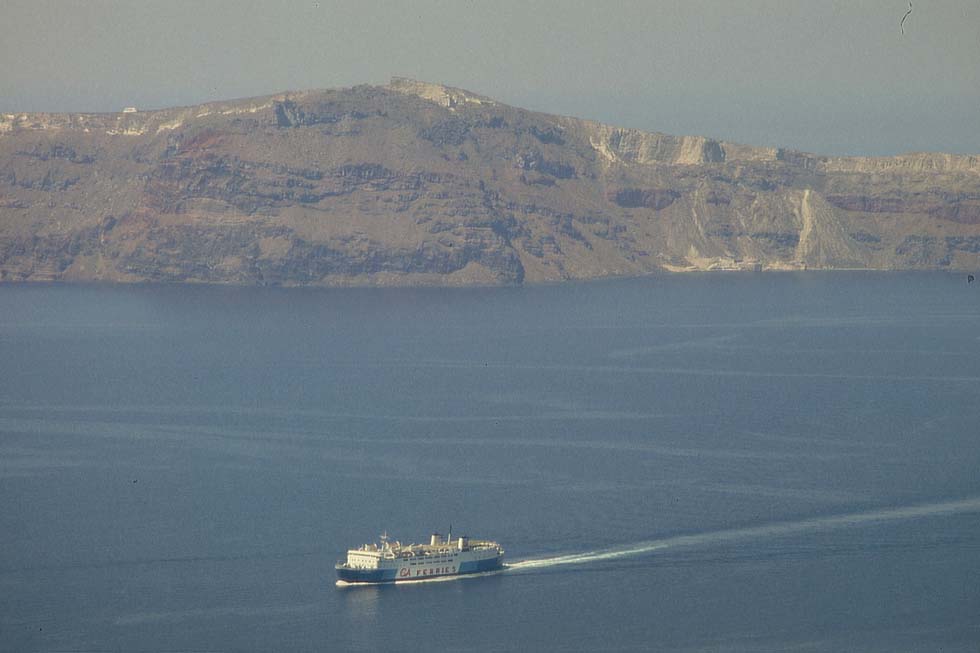
GA Ferry arriving at Santorini, 2007
|